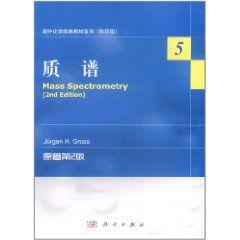內容簡介
《質譜(原著第2版)(英文版)》作為一部成功的教科書,其全新修訂的第2版在內容上得以充分的擴展,以其詳盡和準確的敘述,精美的插圖和照片為讀者津津樂道。?新增串級質譜法,涵蓋了儀器設備、離子激活方法(CID,ECD,ETD,IRMPD)及其套用?新增敞開式質譜(DART,DESI等),新增無機質譜,包含元素形態分析和成像,?新增了所有章節的學習目標,新增先進儀器介紹,諸如orbitraps、線性離子阱、串級TOFs、FT-ICR,以及各種聯用儀器。JurgenH.Gross對書中的概念、方法和技術做出了深入的闡述。指導學生和專業人員從新手逐步成長為質譜套用的行家裡手。JurgenH.Gross首先介紹了氣相離子化學原理、同位素組成和精確質量,然後是各種質量分析器和離子化方法的設計,最後是質譜圖的解析和聯用技術。可以說《質譜(原著第2版)(英文版)》是實用信息和基於豐富文獻的理論知識的完美結合。
目錄
Table of Contents
1 Introduction
Learning Objectives
1.1 Aims and Scope
1.1.1 Filling the Black Box
1.2 What Is Mass Spectrometry?
1.2.1 Mass Spectrometry
1.2.2 Mass Spectrometer
1.2.3 Mass Scale
1.2.4 Mass Spectrum
1.3 Ion Chromatograms
1.4 Performance of Mass Spectrometers
1.4.1 Sensitivity
1.4.2 Detection Limit
1.4.3 Signal-to-Noise Ratio
1.5 Terminology - General Aspects
1.5.1 Basic Terminology in Describing Mass Spectra
1.6 Units, Physical Quantities, and Physical Constants
References
2 Principles of Ionization and Ion Dissociation
Learning Objectives
2.1 Gas Phase Ionization by Energetic Electrons
2.1.1 Formation of Ions
2.1.2 Processes Accompanying Electron Ionization
2.1.3 Ions Generated by Penning Ionization
2.1.4 Ionization Energy
2.1.5 Ionization Energy and Charge-Localization
2.2 Vertical Transitions
2.3 Ionization Efficiency and Ionization Cross Section
2.4 Internal Energy and the Further Fate of Ions
2.4.1 Degrees of Freedom
2.4.2 Appearance Energy
2.4.3 Bond Dissociation Energies and Heats of Formation
2.4.4 Randomization of Energy
2.5 Quasi-Equilibrium Theory
2.5.1 QET's Basic Premises
2.5.2 Basic QET
2.5.3 Rate Constants and Their Meaning
2.5.4 k(E) Functions - Typical Examples
2.5.5 Reacting Ions Described by k(E)Functions
2.5.6 Direct Cleavages and Rearrangement Fragmentations
2.6 Time Scale of Events
2.6.1 Stable, Metastable, and Unstable Ions
2.6.2 Time Scale of Ion Storage Devices
2.7 Internal Energy - Practical Implications
2.8 Reverse Reactions and Kinetic Energy Release
2.8.1 Activation Energy of the Reverse Reaction
2.8.2 Kinetic Energy Release
2.8.3 Energy Partitioning
2.9 Isotope Effects
2.9.1 Primary Kinetic Isotope Effects
2.9.2 Measurement of Isotope Effects
2.9.3 Secondary Kinetic Isotope Effects
2.10 Determination of Ionization Energies
2.10.1 Conventional Determination of Ionization Energies
2.10.2 Improved IE Accuracy from Data Post-Processing
2.10.3 IE Accuracy - Experimental Improvements
2.10.4 Photoionization Processes
2.11 Determining the Appearance Energies
2.11.1 Kinetic Shift
2.11.2 Breakdown Graphs
2.12 Gas Phase Basicity and Proton Affinity
References
3 Isotopic Composition and Accurate Mass
Learning Objectives
3.1 Isotopic Classification of the Elements
3.1.1 Monoisotopic Elements
3.1.2 Di-isotopic Elements .
3.1.3 Polyisotopic Elements
3.1.4 Representation of Isotopic Abundances
3.1.5 Calculation of Atomic, Molecular, and Ionic Mass
3.1.6 Natural Variations in Relative Atomic Mass
3.2 Calculation of Isotopic Distributions
3.2.1 Carbon: An X+I Element
……
4 Instrumentation
5 Practical Aspects of Electron Ionization...
6 Fragmentation of Organic Ions and Interpretation of E1 Mass Spectra
7 Chemical Ionization
8 Field Ionization and Field Desorption
9 Tandem Mass Spectrometry
10 Fast Atom Bombardment
11 Matrix-Assisted Laser Desorption/Ionization
12 Electrospray Ionization
13 Ambient Mass Spectrometry
14 Hyphenated Methods
15 Inorganic Mass Spectrometry
Appendix
Subject Index

